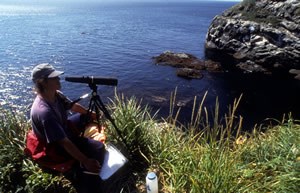 The area affected by the Exxon Valdez oil spill supports a high abundance and diversity of marine birds throughout the year. Approximately one million marine birds inhabited the area prior to the spill, of which an estimated 100,000 to 300,000 initially died. The Trustee Council has funded marine bird research and monitoring projects since 1990, which have provided important insights into the ecology of seabirds, as well as the process of recovery from the oil spill. In turn, these data provide a window into the health and recovery status of the ecosystem as a whole. For example, research and monitoring of the harlequin duck, indicated the unanticipated duration of exposure to lingering oil in the nearshore zone, as well as the subsequent effects on individuals and populations. This work has been important for understanding the consequences of chronic exposure to residual oil still available to birds and mammals in the spill area, long after the immediate, acute effects are over. In addition to documenting the processes and constraints to recovery from the spill, the research and monitoring funded by the Trustee Council, have provided datasets that serve as benchmarks to detect future changes in the ecosystem.
The area affected by the Exxon Valdez oil spill supports a high abundance and diversity of marine birds throughout the year. Approximately one million marine birds inhabited the area prior to the spill, of which an estimated 100,000 to 300,000 initially died. The Trustee Council has funded marine bird research and monitoring projects since 1990, which have provided important insights into the ecology of seabirds, as well as the process of recovery from the oil spill. In turn, these data provide a window into the health and recovery status of the ecosystem as a whole. For example, research and monitoring of the harlequin duck, indicated the unanticipated duration of exposure to lingering oil in the nearshore zone, as well as the subsequent effects on individuals and populations. This work has been important for understanding the consequences of chronic exposure to residual oil still available to birds and mammals in the spill area, long after the immediate, acute effects are over. In addition to documenting the processes and constraints to recovery from the spill, the research and monitoring funded by the Trustee Council, have provided datasets that serve as benchmarks to detect future changes in the ecosystem.
